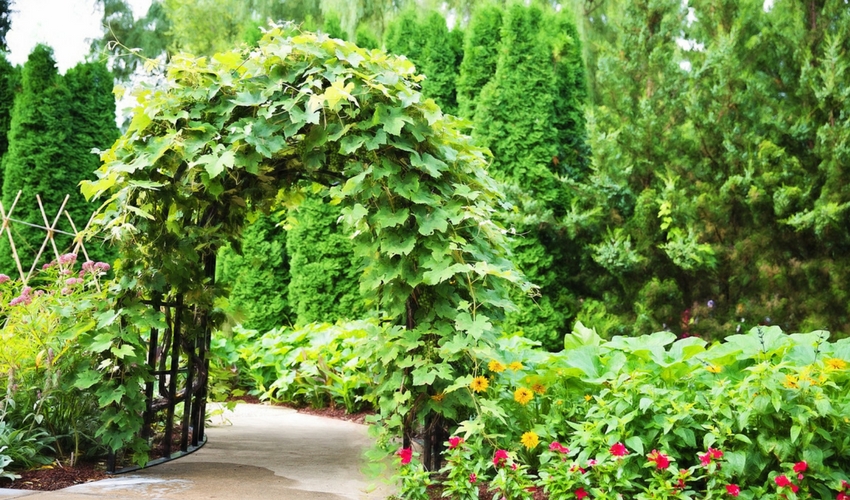Build a Vine-Covered Archway to your Yard
Feb 19th 2021

How to Enjoy a Fine Vine all Summer Long
Often located at the entrance to a garden or patio area, a "pergola" is a vine-covered gateway that's crawling with flowering vines and can help even a small space feel distinctive.
Despite the fancy Italian name, a pergola is essentially just a series of 2, 3, 4 or 5 arches interconnected with vine-covered lattices. As impressive as they look, they're not particularly difficult to build...providing you have basic carpentry and gardening skills.
Before you begin, you'll want to check out a few different styles and think about what model best fits your garden. But the basic design involves two upright posts for each section, with a crosspiece connecting them. The posts should rise at least seven feet from the ground, and you'll want to make the archway roughly three feet wide, so you can walk through it. If you have room, it's also nice to leave extra space for a bench, making a shady summer-sitting spot.
Of course, you'll also need to choose the type of vine you want to grow. A few favorites:
- Clematis--blooms white, pink, red, purple, blue and burgundy
- Coral honeysuckle--blooms reddish, yellow or orange
- Wisteria--known for its scented flowers
- Porcelain vine--decorative berry clusters, gnarled stems and green-and-white leaves have a classic natural look.
Ask local experts what grows well where you live. And remember: aggressive vines will engulf nearby plants so try to leave some space between them and any cherished plants, unless you want a garden version of Attila the Hun's rampage across Europe.
Once you've decided on style and dimensions, it's time to start building.
THINGS YOU'LL NEED:
- Post hole digger & cement (if digging post holes)
- Post spikes and sledge hammer (if using post spikes)
- Weather-resistant 4x4 posts (2 per archway)
- Level
- Measuring tape
- Crosspiece, straight or curved (1 per archway)
- Lattice for the sides and top
- Saw
- Hammer (or drill)
- Nails (or screws)
- Vine seeds or cuttings
- Vine tying material (twine, nylons, etc.)
- Cut the posts from pressure-treated lumber, redwood or cedar heartwood (available at your local lumber center). To set the posts you can either dig holes and plant spikes.
For holes: Use a post hole digger to create 18-inch-deep holes (remember to calculate that 18 inches when cutting your posts! 7-ft. posts should be cut 8 1/2 feet long). Slide the posts in the hold. In firm ground you can just fill in around the hole and tamp the dirt down In softer soil, or in harsher environments, you may want to pour cement into the hole to create firmer footing. As you install it, use a level to make sure the post is straight.
For spikes: Drive the spike into the ground with the sledge hammer. Make sure that the post spike is level by using the spirit level. Check the level at periodic intervals when pounding in the spike. When all of the spike is in the ground, that is, all you can see is the square where the post goes, stop. Insert the post and adjust the post spike, if necessary, so that it is level and holds the post securely. - Next, nail or screw a 2-inch thick crosspiece between the posts to form an upright rectangle, or archway if you use a curved crosspiece. Since vines are not particularly heavy, this crosspiece need not be massive. Again, consider the environment and make sure it will stand up to local storms.
Repeat steps 1 & 2 for each archway that will be in your pergola. - Using nails or screws, connect the sides of the archways with wood or wire lattices from which the vines will grow. If you want vines overhead, then also create a roof-like structure with the lattice. If the archways are close enough together, you can just extend the lattice from one crosspiece to another. If they're too far apart, you'll need to first create "beams" by attaching 2x2 pieces of wood that span all the crosspieces, then attach the lattice atop them.
- Start the vines growing about a foot from the structure. Once the stems are long enough, tie them to the lattice with soft material--like strips cut from old pantyhose--which won't nick the stem as it grows or whips around during storms. As the vine lengthens, continue to tie its tendrils higher on the lattice, creating the pattern of growth that you want. You'll quickly discover that vines can be bent to fit almost any form because the leaves rapidly reorient themselves toward the sun, creating an orderly appearance.

